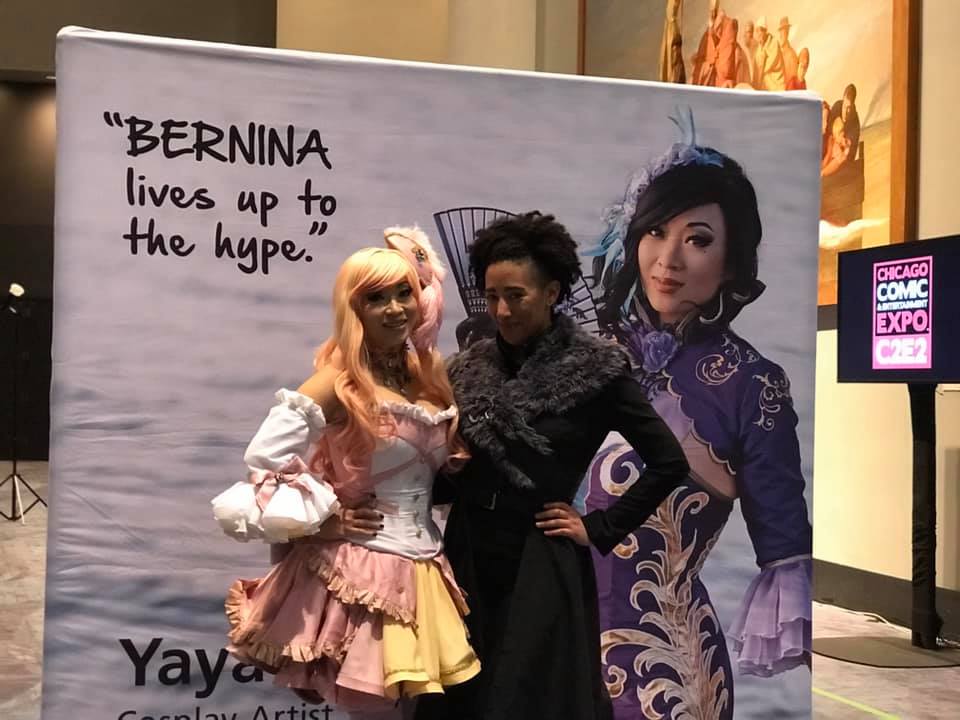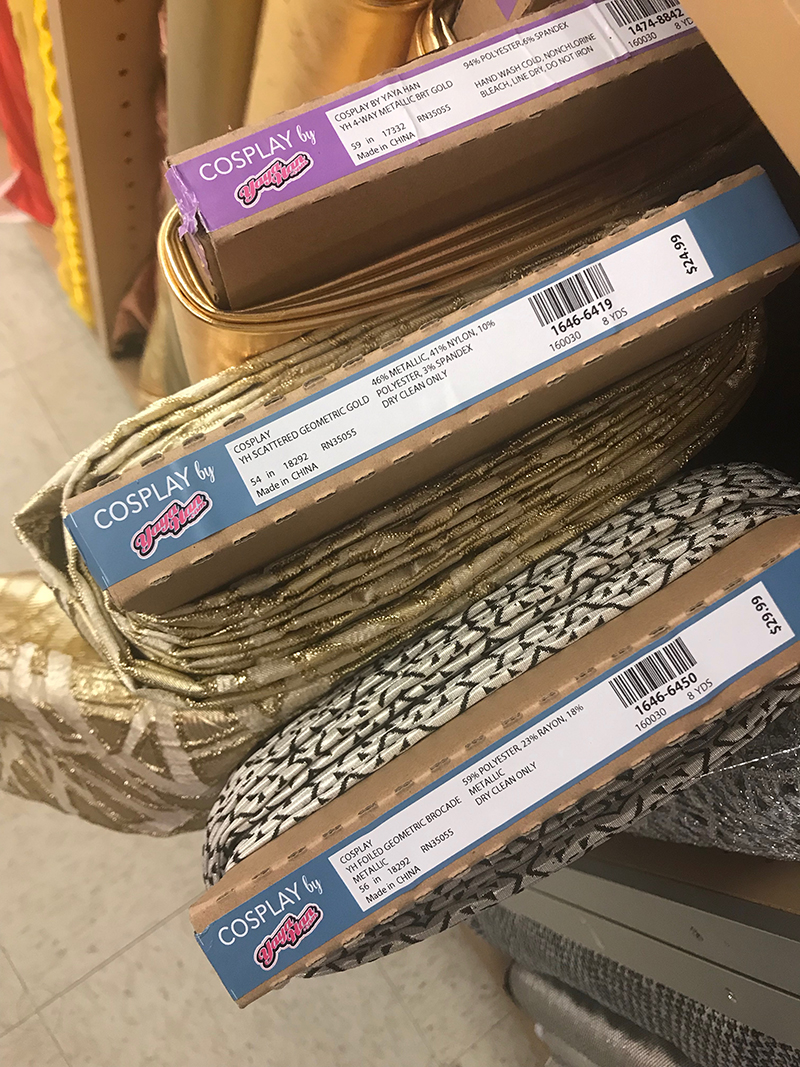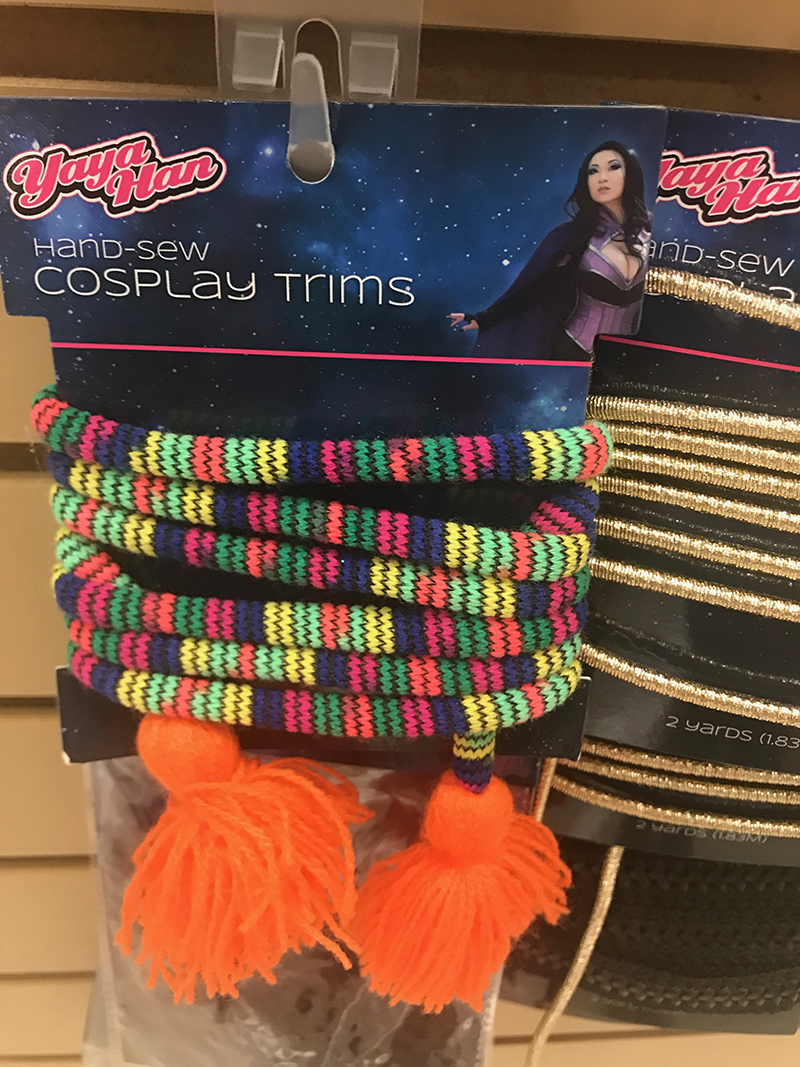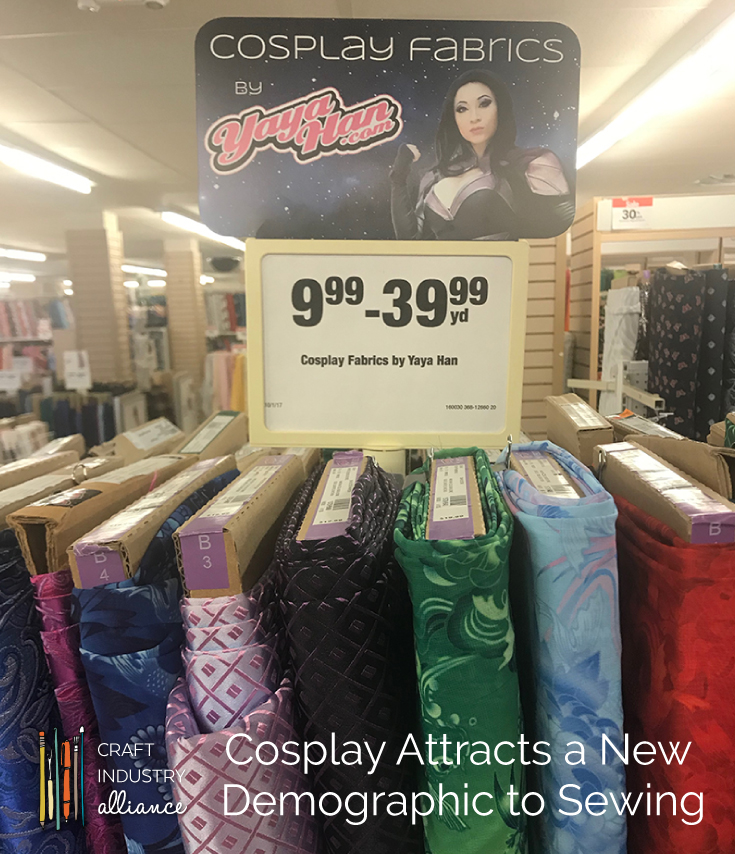
Yaya Han poses in the Bernina booth at Chicago Comic and Entertainment Expo, held March 22-24, 2019.
Photo courtesy of Bernina USA
“My mom is a big quilter so she taught me the very basics of sewing probably when I was like eight or so,” Toth says, but it had been years since she’d sewn anything. To make Risa’s signature white and crimson outfit, Toth drew with Sharpie on an old button-down shirt, dyed a skirt and then glued a ribbon around its edge. The results weren’t spectacular, but Toth was hooked. “Being able to make something that I’ve seen on TV and then wearing it around and having people recognize you as that character? It’s really fun,” she says. She’s gone on to cosplay at Bronycon, FairfaxComicon, the Maryland Renaissance Festival, Katsucon and more. She even has an Instagram account devoted to her cosplay, @sugarshockcosplay. This year she asked for a sewing machine for her birthday. Her mom was happy to oblige.
The market opportunity is sizable. The comics convention industry grossed $5 billion last year at over 900 events nationwide, and 38% of comic con attendees attended those shows dressed up in some kind of costume.
Cosplay, or costume play, originated in Japan in the early 1990s, and for a long time in the US it was something only comic book geeks participated in. Cheryl Sleboda, sewing instructor and owner of the specialty product Sew Much Cosplay, recalls many years when cosplayers were not cool. “You were nerdier than the other nerds,” she laughs. But in the last few years that perception has changed. “It’s a good time to be a nerd now,” Sleboda says, noting that cosplay has appeared recently on popular TV shows like CBS’s Big Bang Theory.


Having spent the prior 20 years working in the comic book industry, Sleboda has been able to successfully bridge the gap between both worlds. She recognized that cosplayers have a particular set of needs when it comes to sewing. “There are challenges with cosplay that are different from a costume you’d make for Halloween,” she explains. “The costume needs to be wearable all day. It needs to be light and breathable. It needs to be packable in a suitcase and come out of that suitcase in a form that you could wear and possibly win a contest.” Sleboda partnered with Knoxville-based RNK Distributing to source and manufacture interlinings and foam that bounce back to their original shape. Everything can be washed.
Still, some shops have been hesitant to jump in. “We’re not your normal market,” says Toth of the cosplay community. “We’re nerdy, mostly younger people. I think a big fear a lot of cosplayers have is that people will think we’re weird.” At times, she says, this fear of judgement has prevented her from going into the independently owned stores near her, although she’d like to patronize them more.
Toth wants to reassure hesitant shop owners that cosplayer don’t expect them to know every anime or comics character. “I don’t know every character either. Just ask to see a picture. If someone loves a character enough to make their outfit, they’ll talk about them to anybody.”

Cheryl Sleboda at at Chicago Comic and Entertainment Expo, held March 22-24, 2019.
Photo courtesy of Cheryl Sleboda
Recently, though, that perception is changing. “Now when I go to Sew Expo and The Original Sewing & Quilt Expo, people are so happy the cosplayers are there. They’ll tell me, ‘Oh, I’m so glad you’re here doing this cosplay thing. This is what we’ve needed.’ So I think they’re starting to get it,” Sleboda says.
For shops who are just getting started with the cosplay community one idea is to partner with a comics bookstore for an event. “There are lots of people that I think would want to start cosplaying, but don’t even know where to begin,” Toth says. “If it’s already in a familiar environment, that makes it easier.”



Yaya Han cosplay fabric and trim available at at JOANN.
Photos by Abby Glassenberg
Glass estimates that only five of every hundred people she talks to at the shows know anything about sewing machines.
“We had an embroidery machine set up in the booth stitching out Marvel Comics designs. People kept asking if it was a 3D printer,” she says. “We realized how little knowledge people have so we’ve started simplifying what we bring.”
To welcome cosplayers into the store, the Singer Sewing Center offers a cape-making class that doubles as an introductory sewing class the week leading up to ComicCon. “Every year we get more and more people coming in to get their hero foam to make their swords and armor,” Glass says. “As a shop owner, we try everything. Why not?”


I knitted a scarf that I was able to replicate from an episode of Kimmy Schmidt and found a woman locally who dressed up as Kimmy for a cosplay. I found her through instagram, and it was a miracle of sorts that she was living in the same city. The pictures are still among my favorites. Also, there is knitting culture around Game of Thrones, so cosplay is not limited to sewing. Though sewing is a bigger part of it. I think it’s an amazing way to reach younger people and get them involved in crafting in a way that reaches them. Not everyone wants to make pot holders or curtain valances. And if a cape reaches a 25 year old and gets them into sewing, then I think it’s great. They will probably outgrow wearing the cape, but they will most likely continue sewing. (or knitting)
I currently have a 16 year old girl in my sewing class making a cosplay costume – an anime character. She’s never sewn before except for a pencil case in home ec, and didn’t have a sewing machine until two days before her first class. She is using a regular sewing pattern (it’s an 80’s prom dress pattern, adapted) and I think it has opened her eyes to the possibilities of making her own clothes. Cosplay is an extreme of “making whatever you want” and sewing unique clothes for yourself is only a couple of (very achievable) notches down from that.
In my area LARPING is gaining popularity. People that dress up in medieval clothing and fight with foam weapons. Making custom clothing and specific items has been keeping me busy and my pocketbook happy. With the popularity of Game of Thrones cosplay it’s been fun.
I am enjoying thetremendous variety of fabrics available. I make dragons and other fantasy animals. Now I have such an incredible variety of fabric textures and colors to choose from. As if I did not already have a lot of fabric!
I’d love to know what the needs are around interfacings and battings for cosplay – anyone have thoughts on this?
Steph
The needs for interacting and batting can range a lot depending on the cosplay outfit. Interacting is in great use if your outfit has a corset or a standing collar. In cosplay you want to be about to wear the piece say 20 times. I have seen batting used for padding in a outfit but overall not a ton of use of batting.
I’m 50, and I’m a cosplayer who makes my own (and my husband’s) costumes. I have several completed ones, and several more in varying stages of completion. I can attest that there is a huge market for this type thing. The estimate of 38% of attendees being in cosplay seems to me to be low from what I’ve seen at conventions, especially at Dragoncon. Cosplayers in my experience are looking for a variety of things- some are looking for an easy costume to create, others are looking for total screen accuracy, regardless of difficulty. Some want to buy their props ready made, while others want to unleash their creativity and make something unique out of something unexpected. I once met a Dr. Strange cosplayer who had made an Eye of Agamotto pendant from an old car floor mat that same morning. The range and appeal and possibilities of this market are really limitless.
Thank you for sharing this perspective, Holly!